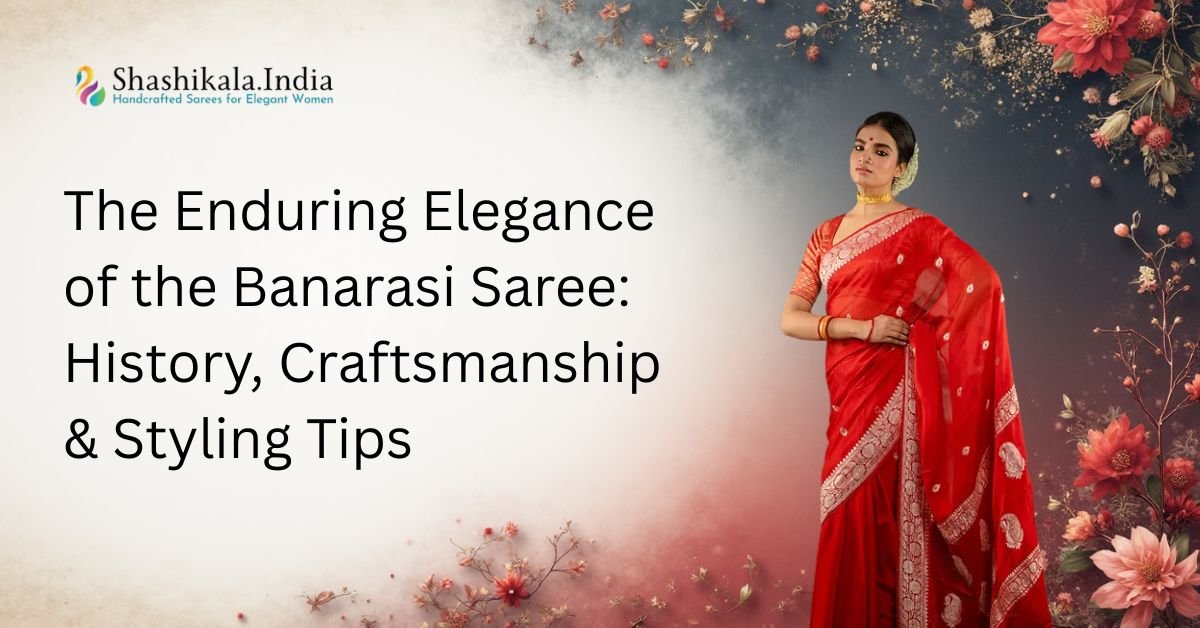Not all Banarasi sarees are made the same way. In India, it is a symbol of celebration, culture, and class. It is worn by brides at weddings. At festivals, women wear it. Even young girls pick it for special occasions. A Banarasi silk saree is always in style. Even after all these years, it still looks royal.
Shashikala is well known for its high-quality Banarasi handloom sarees. Because Shashikala carefully selects each saree from talented weavers, many ladies have faith in the brand.
History & Cultural Significance of Banarasi Sarees
Banarasi sarees have a history going back more than 500 years. Varanasi, Uttar Pradesh, is the source of the art. Zari work and exquisite silk weaving gained popularity during the Mughal era. Kings and queens used Banarasi silk as a symbol of wealth and authority.
Weaving Craftsmanship & Techniques
A traditional handloom saree takes weeks or even months to make a Banarasi saree. Each motif is hand-woven by talented artisans while seated on looms. Fine threads coated with gold or silver are used to make the zari. Although the weaving takes time, the end product is Satisfactory and beautiful.
Banarasi sarees can be made in 2 primary ways:
- Handloom (pure handwoven Banarasi) – real, traditional, rare, takes a long time.
- Powerloom (machine-made Banarasi) – Cheaper, faster, but less detailed.
Because a Banarasi handloom is created by human hands, it will always have some imperfections. That’s what makes it original weaving so beautiful.
Types & Motifs of Banarasi Sarees
Banarasi sarees come in different types based on fabric and weaving.
Famous Types:
- Katan Banarasi – made from pure silk threads twisted together, smooth and strong.
- Kora (Organza) Banarasi – light, transparent, and elegant.
- Georgette Banarasi – soft, flowy, and easy to drape.
- Shattir Banarasi – used for trendy and modern designs.
Popular Motifs Seen in Banarasi Sarees:
- Butidar flowers are small floral designs created with silver and gold threads. They make the saree appear beautiful and vibrant.
- Mughal-style creepers: Mughal art inspired these lengthy vine-like designs. They provide the pallu and saree border with elegance and regal beauty.
- Paisley motifs: Paisley, sometimes referred to as “Kairi” or “ambi,” is a teardrop-shaped pattern. It is among the most beloved and classic motifs seen in sarees.
- Shikargah (animal scenes): This motif depicts hunting scenes involving deer and elephants. Luxurious Banarasi sarees feature this unique and traditional design.
- Jal (all over net-like pattern): Jal means “net” or “mesh.” It gives the entire saree a majestic and consistent appearance by covering it with a delicate, interconnected design.
Every motif has meaning. It shows the beauty and culture of Indian art.
Styling Tips – Traditional & Modern
A Banarasi saree looks good on both classic and modern occasions. Here are some easy styling ideas:
Traditional Look
- Wear with gold or temple jewellery
- Bun hairstyle with gajra
- Red or maroon lipstick
Modern Look
- Pair with a belt for a fusion drape
- Wear pearl jewellery
- Open hair or sleek ponytail
Even simple makeup looks royal when you wear Bharasi silk.
How to Care for Banarasi Sarees
Banarasi sarees are valuable and need to be treated with caution.
- Make sure to dry-clean them consistently. Because it’s delicate, banarasi silk should not be washed at home. Dry cleaning prevents shrinking and damage to the fabric and zari.
- Don’t always fold in the same lines. Repeatedly folding along the same crease might weaken the silk and break the zari. To keep the saree safe, switch up the folds.
- Use a soft cotton cloth to store. The saree can be protected from moisture and dust by wrapping it in a soft, breathable material. Plastic retains moisture, so never store it in it.
- Avoid exposure to sunlight and moisture. Sunlight damages silk threads and causes color fading. Store in a cool, dry location because moisture leads to fungus and discoloration.
- Once every 2 to 3 months, let them air out. Occasionally, take the saree outside and leave it open for a few hours in the shade. By doing this, odor, mildew, and stiff fabric are avoided.
Banarasi sarees can last for 40 to 50 years if properly cared for.
Why Shop Banarasi Sarees from Shashikala
Shashikala specializes in carefully chosen handloom Banarasi sarees that come straight from reliable craftspeople. The quality of the zari, weaving, and silk purity is checked in every saree. Shashikala offers high-quality, long-lasting, and culturally significant sarees, which is why many brides and saree collectors choose them.
Shashikala is a reliable place to look if you are looking for a Banarasi saree that you may wear for many years and possibly pass on to the next generation.
Conclusion – A Saree That Lives Longer Than Fashion
There is more to a Banarasi saree than just fabric. It’s a combination of time, expertise, history, and emotion. You are putting centuries’ worth of artistic creations on your body when you drape one. This is the reason why women still wear banarasi sarees to festivals and weddings nowadays.
If you are planning to buy a Banarasi saree soon, explore the handpicked collection at Shashikala for authentic, premium, and timeless pieces that you will cherish forever.
FAQ
Q1. What makes Banarasi sarees special?
Their fine silk, handwoven craftsmanship, and rich zari work make them unique.
Q2. Are Banarasi sarees good for weddings?
Yes, Banarasi silk is one of the top choices for Indian bridal sarees.
Q3. How to style a Banarasi saree in a modern way?
Wear with a statement blouse, pearl jewellery, or a belt drape.





Add comment